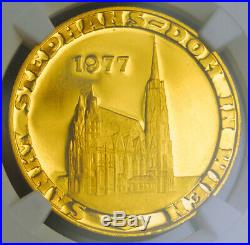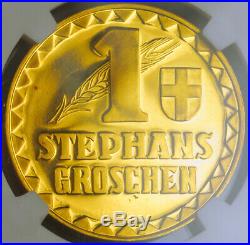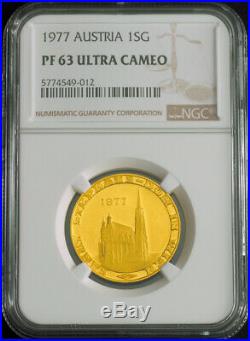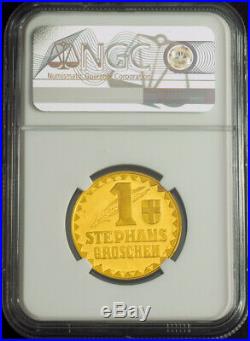




Beautiful Proof Gold 1 Stephans Groschen Coin. Mint Year: 1977 Mint Place: Vienna Denomination: Gold 1 Stephans Groschen References: Friedberg -, Bruce. Certified and graded by NGC as PF-63! 585 Dimensions: 27mm Weight: 11.48gm. Obverse: Perspective view of the Saint Stephen´s Cathedral in Vienna. Legend: SANKT STEPHANS-DOM IN WIEN. Reverse: Large value numeral (1) on a wheat-spray above denomination (STEPHANS GROSCHEN). Coat-of-arms of Vienna in upper right field. Legend: 1 STEPHANS GROSCHEN. The “Stephans Groschen” was a fictive currency unit, which was usually struck in aluminum at the Vienna mint and exchanged for a donation of 1 Schilling, which is collected by the general public for the annual reparation works on the Saint Stephen´s Cathedral in Vienna. Nowadays these pieces are not issued anymore, instead a small stamp-like ticket is being received. The specimen we have here was struck with polished dies (a proof coin) and in gold (585 = 58.5% purity) Here it is struck in gold and with polished dies. Such a piece would be probably given to very generous donators which of course spent more than the usual minumum of 1 Schilling for the most recognizable and beloved cathedral and symbol of Vienna, the capital of Austria. Stephen’s Cathedral more commonly known by its German title. Is the mother church of the Roman Catholic Archdiocese of Vienna and the seat of the Archbishop of Vienna, Christoph Cardinal Schönborn, OP. The current Romanesque and Gothic form of the cathedral, seen today in the Stephansplatz, was largely initiated by Duke Rudolf IV (13391365) and stands on the ruins of two earlier churches, the first a parish church consecrated in 1147. The most important religious building in Vienna, St. Stephen’s Cathedral has borne witness to many important events in Habsburg and Austrian history and has, with its multi-coloured tile roof, become one of the city’s most recognizable symbols. By the middle of the 12th century, Vienna had become an important centre of German civilization, and the four existing churches, including only one parish church, no longer met the town’s religious needs. In 1137, Bishop of Passau Reginmar and Margrave Leopold IV signed the Treaty of Mautern, which referred to Vienna as a. For the first time and transferred St. Peter’s Church to the Diocese of Passau. Under the treaty, Margrave Leopold IV also received from the bishop extended stretches of land beyond the city walls, with the notable exception of the territory allocated for the new parish church, which would eventually become St. Although previously believed built in an open field outside the city walls, the new parish church was in actuality likely built on an ancient cemetery dating to Ancient Roman times; excavations for a heating system in 2000 revealed graves 2.5 metres (8.2 ft) below the surface, which were carbon-dated to the 4th century. This discovery suggests that an even older religious building on this site predated the St. Rupert’s Church, which is considered the oldest church in Vienna. Founded in 1137 following the Treaty of Mautern, the partially constructed Romanesque church was solemnly dedicated in 1147 to Saint Stephen in the presence of Conrad III of Germany, Bishop Otto of Freising, and other German nobles who were about to embark on the Second Crusade. [2] Although the first structure was completed in 1160, major reconstruction and expansion lasted until 1511, and repair and restoration projects continue to the present day. From 1230 to 1245, the initial Romanesque structure was extended westward; the present-day west wall and Romanesque towers date from this period. In 1258, however, a great fire destroyed much of the original building, and a larger replacement structure, also Romanesque in style and reusing the two towers, was constructed over the ruins of the old church and consecrated 23 April 1263. The anniversary of this second consecration is commemorated each year by a rare ringing of the Pummerin bell for three minutes in the evening. In 1304, King Albert I ordered a Gothic three-nave choir to be constructed east of the church, wide enough to meet the tips of the old transepts. Under his son Duke Albert II, work continued on the Albertine choir, which was consecrated in 1340 on the 77th anniversary of the previous consecration. The middle nave is largely dedicated to St. Stephen and All Saints, while the north and south nave, are dedicated to St. Mary and the Apostles respectively. Albert II’s son, expanded the choir again to increase the religious clout of Vienna. On 7 April 1359, Rudolf IV laid the cornerstone for a westward Gothic extension of the Albertine choir in the vicinity of the present south tower. This expansion would eventually encapsulate the entirety of the old church, and in 1430, the edifice of the old church was removed from within as work progressed on the new cathedral. The south tower was completed in 1433, and vaulting of the nave took place from 1446 to 1474. The foundation for a north tower was laid in 1450, and construction began under master Lorenz Spenning, but its construction was abandoned when major work on the cathedral ceased in 1511. In 1365, just six years after beginning the Gothic extension of the Albertine choir, Rudolf IV disregarded St. Stephen’s status as a mere parish church and presumptuously established a chapter of canons befitting a large cathedral. This move was only the first step in fulfilling Vienna’s long-held desire to obtain its own diocese; in 1469, Emperor Frederick III prevailed upon Pope Paul II to grant Vienna its own bishop, to be appointed by the emperor. Despite long-standing resistance by the Bishops of Passau, who did not wish to lose control of the area, the Diocese of Vienna was canonically established 18 January 1469, with St. Stephen’s Cathedral as its mother church. In 1722 during the reign of Karl VI, Pope Innocent XIII elevated the see to an archbishopric. During World War II, the cathedral was saved from intentional destruction at the hands of retreating German forces when. Captain Gerhard Klinkicht disregarded orders from the city commandant, “Sepp” Dietrich, to “fire a hundred shells and reduce it to rubble”. On 12 April 1945, civilian looters lit fires in nearby shops as Soviet Army troops entered the city. The winds carried the fire to the cathedral, where it severely damaged the roof, causing it to collapse. Fortunately, protective brick shells built around the pulpit, Frederick III’s tomb, and other treasures, minimized damage to the most valuable artworks. However, the Rollinger choir stalls, carved in 1487, could not be saved. Reconstruction began immediately after the war, with a limited reopening 12 December 1948 and a full reopening 23 April 1952. The item “1977, Austria. Vienna. Beautiful Proof Gold 1 Stephans Groschen Coin. NGC PF-63″ is in sale since Monday, May 11, 2020. This item is in the category “Coins & Paper Money\Coins\ World\Europe\Austria”. The seller is “coinworldtv” and is located in Wien. This item can be shipped worldwide.
- Composition: Gold
- Country/Region of Manufacture: Austria
- Certification Number: 5774549-012
- Certification: NGC
- Grade: PF63
- Year: 1977

